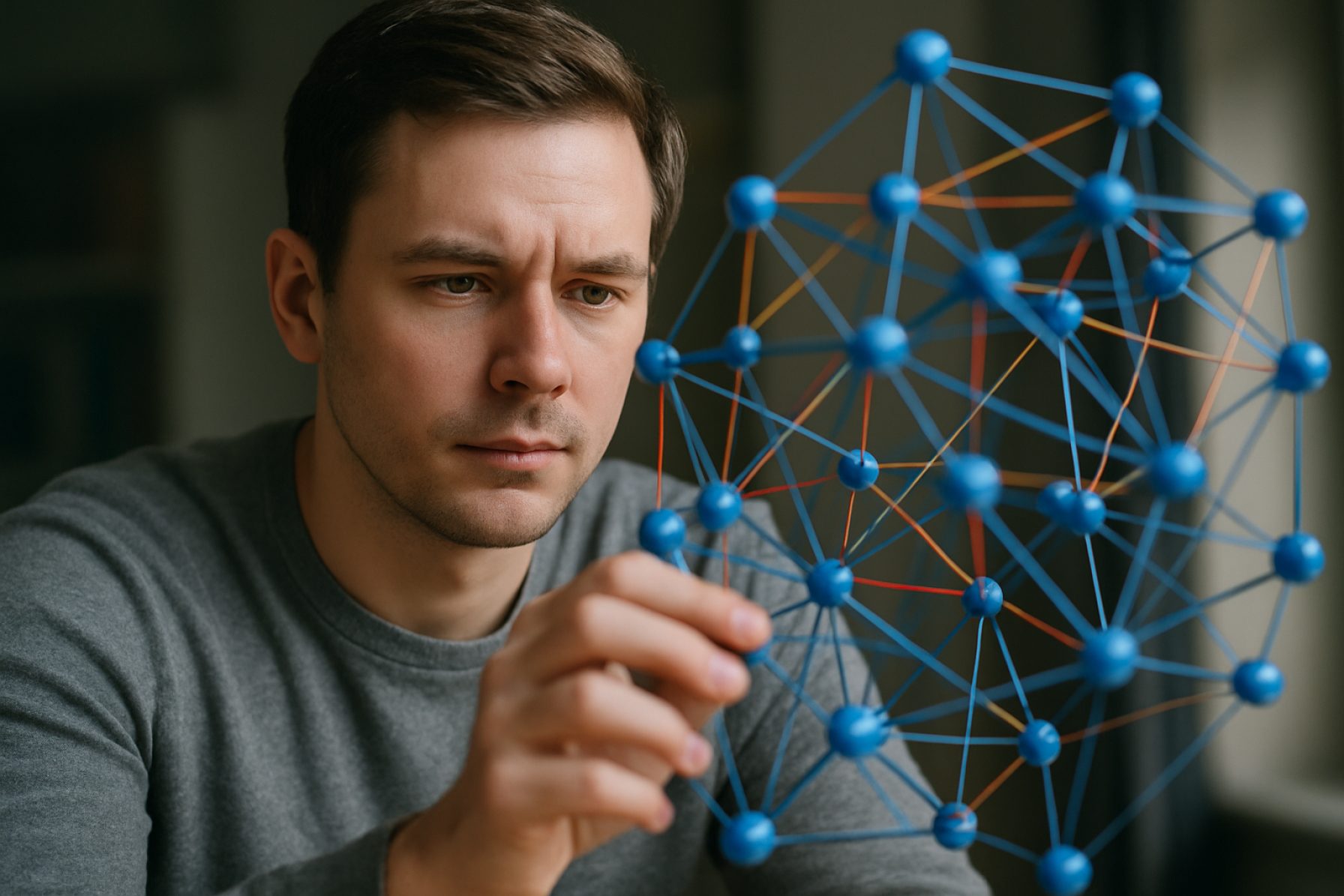
How the Newman–Watts Small-World Network Revolutionizes Complex Systems: Bridging Randomness and Order for Next-Gen Connectivity (2025)
- Introduction to Small-World Networks and Their Significance
- The Genesis: Watts–Strogatz vs. Newman–Watts Models
- Mathematical Foundations and Key Properties
- Real-World Applications: From Neuroscience to Social Media
- Algorithmic Construction and Simulation Techniques
- Comparative Analysis with Other Network Models
- Impact on Network Robustness and Information Flow
- Recent Advances and Research Frontiers
- Market and Public Interest: Growth Trends and Forecasts
- Future Outlook: Emerging Technologies and Societal Implications
- Sources & References
Introduction to Small-World Networks and Their Significance
Small-world networks are a class of graphs that capture the balance between local clustering and short global separation, a property observed in many real-world systems such as social networks, neural networks, and technological infrastructures. The concept was first formalized in the late 1990s, notably through the work of Duncan J. Watts and Steven H. Strogatz, who introduced the Watts–Strogatz model to explain how networks can simultaneously exhibit high clustering coefficients and low average path lengths. This discovery provided a mathematical framework for understanding phenomena like the “six degrees of separation” in social systems and the rapid spread of information or diseases.
Building on this foundation, the Newman–Watts small-world network model was proposed as a refinement to address certain limitations of the original Watts–Strogatz approach. In the Watts–Strogatz model, a regular lattice is rewired with a given probability, which can sometimes lead to disconnected components. The Newman–Watts model, introduced by Mark Newman and Duncan J. Watts, instead adds random shortcuts to a regular lattice without removing any existing edges. This subtle modification ensures the network remains connected, making it more suitable for analytical studies and practical applications where connectivity is essential.
The significance of the Newman–Watts small-world network lies in its ability to more accurately represent the structure of many complex systems. For example, in neuroscience, the brain’s neural network exhibits small-world properties, facilitating efficient information transfer with minimal wiring cost. In epidemiology, small-world models help explain how diseases can spread rapidly even when most interactions are local. The Newman–Watts model, by preserving connectivity, allows researchers to study these dynamics without the confounding effects of network fragmentation.
Moreover, the study of small-world networks has influenced a wide range of disciplines, from physics and biology to computer science and engineering. The mathematical properties of these networks—such as their resilience to random failures and their efficiency in information dissemination—have inspired the design of robust communication protocols and distributed systems. Organizations like the American Physical Society and the American Mathematical Society have played key roles in disseminating research on network theory, including small-world phenomena, through their journals and conferences.
As of 2025, the Newman–Watts small-world network remains a foundational model for understanding and simulating the complex interplay between local and global connectivity in diverse systems. Its continued relevance underscores the importance of network science in addressing contemporary challenges in technology, health, and society.
The Genesis: Watts–Strogatz vs. Newman–Watts Models
The study of complex networks has been revolutionized by models that capture the “small-world” phenomenon—where most nodes can be reached from every other by a small number of steps, yet the network retains a high degree of local clustering. The foundational model in this area is the Watts–Strogatz (WS) model, introduced in 1998 by Duncan J. Watts and Steven H. Strogatz. The WS model begins with a regular lattice and then randomly rewires a fraction of the edges, creating shortcuts that dramatically reduce the average path length while preserving clustering. This model provided a simple yet powerful explanation for the ubiquity of small-world properties in real-world systems, from neural networks to social graphs.
However, the Watts–Strogatz model has certain limitations, particularly regarding the possibility of disconnected components arising from the rewiring process. In 1999, Mark E. J. Newman and Duncan J. Watts proposed a modification to address this issue, resulting in what is now known as the Newman–Watts (NW) small-world network. Instead of rewiring existing edges, the NW model adds new random edges (shortcuts) to the regular lattice without removing any original connections. This subtle but crucial change ensures that the network remains connected, which is essential for many applications in physics, biology, and information science.
The NW model preserves the high clustering coefficient characteristic of the original lattice while introducing enough shortcuts to significantly reduce the average path length, thus maintaining the small-world property. The addition of edges, rather than rewiring, also simplifies analytical treatment and makes the model more robust for simulating real-world networks where connectivity is critical. The NW model has since become a standard reference point in network science, used to study phenomena such as epidemic spreading, synchronization, and information flow.
Both the Watts–Strogatz and Newman–Watts models are now foundational in the field of network theory, which is supported and advanced by organizations such as the American Physical Society and the American Mathematical Society. These organizations foster research and dissemination of knowledge in complex systems, including the mathematical and physical principles underlying small-world networks. As of 2025, the Newman–Watts model continues to be a vital tool for researchers seeking to understand and engineer networks with both high local clustering and efficient global connectivity.
Mathematical Foundations and Key Properties
The Newman–Watts small-world network is a mathematical model designed to capture the essential features of real-world networks, such as social, biological, and technological systems, that exhibit both high clustering and short average path lengths. This model was introduced by Mark Newman and Duncan Watts in 1999 as a refinement of the earlier Watts–Strogatz model, addressing certain limitations while preserving the core small-world characteristics.
Mathematically, the Newman–Watts model begins with a regular ring lattice of N nodes, where each node is connected to its k nearest neighbors. Unlike the Watts–Strogatz model, which rewires existing edges with a certain probability, the Newman–Watts approach adds new edges (shortcuts) between randomly chosen pairs of nodes with a fixed probability p, without removing any of the original lattice connections. This subtle difference ensures that the network remains connected, even for small values of p, and avoids the possibility of isolated nodes or disconnected components.
The key mathematical properties of the Newman–Watts small-world network include:
- Clustering Coefficient: The model maintains a high clustering coefficient, similar to that of the original lattice. The clustering coefficient quantifies the likelihood that two neighbors of a node are also neighbors of each other, reflecting the presence of tightly knit groups within the network.
- Average Path Length: The addition of random shortcuts dramatically reduces the average shortest path length between nodes, a hallmark of small-world networks. Even a small probability p of adding shortcuts is sufficient to ensure that the average path length scales logarithmically with the number of nodes, rather than linearly as in a regular lattice.
- Degree Distribution: The degree distribution in the Newman–Watts model is relatively narrow and does not exhibit the heavy-tailed behavior seen in scale-free networks. Most nodes have a degree close to the original lattice value, with a small fraction having higher degrees due to the added shortcuts.
- Robustness and Connectivity: By construction, the network remains connected for all values of p, which is a significant advantage over models that rely on edge rewiring.
The mathematical tractability of the Newman–Watts model has made it a valuable tool for studying phenomena such as synchronization, epidemic spreading, and information diffusion in complex systems. Its foundational principles are widely referenced in network science literature and have been discussed in detail by organizations such as the American Mathematical Society and the Society for Industrial and Applied Mathematics, both of which are leading authorities in the field of applied mathematics and network theory.
Real-World Applications: From Neuroscience to Social Media
The Newman–Watts small-world network model, introduced as a refinement of the original Watts–Strogatz model, has become a foundational framework for understanding complex connectivity patterns in real-world systems. Its defining feature—high clustering combined with short average path lengths—mirrors the structure of many naturally occurring and engineered networks. This section explores how the Newman–Watts model informs research and practical applications across diverse fields, from neuroscience to social media, as of 2025.
In neuroscience, the architecture of the human brain exhibits small-world properties, facilitating efficient information transfer and robust cognitive function. The Newman–Watts model has been instrumental in simulating neural networks, helping researchers understand how local clusters of neurons (responsible for specialized processing) are interconnected by a few long-range links, enabling rapid communication across different brain regions. This insight has advanced the study of neurological disorders, such as Alzheimer’s disease and epilepsy, where disruptions in small-world connectivity patterns are observed. Leading research institutions, including the National Institutes of Health, have leveraged such models to interpret brain imaging data and to design interventions that aim to restore optimal network function.
In the realm of social media, the Newman–Watts small-world network provides a theoretical basis for the viral spread of information. Social platforms, such as those operated by Meta and X Corp. (formerly Twitter), are characterized by dense local communities (friend groups or interest clusters) interconnected by a relatively small number of bridging users. These bridges dramatically reduce the number of steps required for information to traverse the entire network, explaining phenomena like viral memes and rapid news dissemination. Understanding these dynamics enables platform designers to optimize algorithms for content recommendation and to develop strategies for mitigating the spread of misinformation.
Beyond neuroscience and social media, the Newman–Watts model finds applications in epidemiology, where it helps predict the spread of infectious diseases through populations with both local and long-range contacts. Public health organizations, such as the World Health Organization, utilize small-world network models to simulate outbreak scenarios and to inform vaccination strategies that target key network nodes, thereby enhancing the effectiveness of interventions.
In summary, the Newman–Watts small-world network model serves as a powerful tool for analyzing and optimizing complex systems. Its real-world applications continue to expand, driving innovation in fields as varied as neuroscience, digital communication, and public health.
Algorithmic Construction and Simulation Techniques
The Newman–Watts small-world network is a prominent model in network science, designed to capture the high clustering and short path lengths observed in many real-world systems. Its algorithmic construction and simulation techniques are central to its utility in both theoretical and applied research. The model was introduced as a modification of the original Watts–Strogatz model, aiming to address certain limitations while preserving the essential small-world properties.
The construction of a Newman–Watts small-world network begins with a regular ring lattice, where each of N nodes is connected to its k nearest neighbors. Unlike the Watts–Strogatz model, which rewires existing edges with a certain probability, the Newman–Watts approach adds new edges (shortcuts) between randomly chosen pairs of nodes without removing any of the original lattice connections. This subtle difference ensures that the network remains connected, even for small shortcut probabilities, and avoids the possibility of isolated nodes or disconnected components.
Algorithmically, the process can be summarized as follows:
- Initialize a ring lattice with N nodes, each connected to k nearest neighbors.
- For each possible pair of nodes not already connected, add a shortcut edge with probability p.
This construction is computationally efficient and can be implemented with time complexity proportional to the number of nodes and edges. The addition of shortcuts is typically performed using random number generators to ensure uniform probability across all eligible node pairs. The resulting network exhibits a high clustering coefficient, characteristic of regular lattices, and a low average path length, akin to random graphs.
Simulation of Newman–Watts networks is widely supported in scientific computing environments. For example, the National Science Foundation and research groups at institutions such as Massachusetts Institute of Technology have contributed to the development of open-source libraries and tools that facilitate the generation and analysis of small-world networks. These tools often provide functions for constructing Newman–Watts networks, calculating network metrics, and simulating dynamical processes such as information spreading or epidemic outbreaks.
The robustness of the Newman–Watts model, particularly its guarantee of network connectivity, makes it a preferred choice for simulating real-world phenomena where isolated nodes are undesirable. Its algorithmic simplicity and the availability of efficient simulation techniques have cemented its role in the study of complex systems, from neuroscience to social networks.
Comparative Analysis with Other Network Models
The Newman–Watts small-world network model, introduced as a refinement of the original Watts–Strogatz model, occupies a significant position in the study of complex networks. Its primary innovation lies in the method of introducing randomness: instead of rewiring existing edges, as in the Watts–Strogatz model, the Newman–Watts approach adds new random edges to a regular lattice, preserving the original structure while enhancing connectivity. This subtle difference has important implications when comparing the Newman–Watts model to other canonical network models, such as the Erdős–Rényi random graph, the Barabási–Albert scale-free network, and the original Watts–Strogatz small-world network.
In contrast to the American Mathematical Society-described Erdős–Rényi model, where edges are placed randomly between nodes with a fixed probability, the Newman–Watts model maintains a high clustering coefficient due to its underlying lattice structure. The Erdős–Rényi model, while useful for studying random connectivity, typically exhibits low clustering, making it less representative of many real-world networks, such as social or biological systems, where clustering is prevalent.
The Barabási–Albert model, as outlined by the National Science Foundation, generates networks with a power-law degree distribution, capturing the “rich-get-richer” phenomenon observed in many natural and technological networks. Unlike the Newman–Watts model, which does not inherently produce hubs or a scale-free structure, the Barabási–Albert model is particularly suited for systems where a few nodes accumulate a disproportionately large number of connections. However, the Barabási–Albert model generally lacks the high clustering characteristic of small-world networks.
When compared to the original Watts–Strogatz model, the Newman–Watts network offers improved analytical tractability. By adding rather than rewiring edges, the Newman–Watts model avoids the possibility of disconnecting the network, ensuring that the graph remains connected for all parameter values. This property simplifies mathematical analysis and makes the model more robust for simulating processes such as information diffusion or epidemic spreading, as noted in research supported by the National Science Foundation.
In summary, the Newman–Watts small-world network model bridges the gap between regular lattices and random graphs, combining high clustering with short average path lengths. Its unique construction method distinguishes it from both the Erdős–Rényi and Barabási–Albert models, while offering practical advantages over the original Watts–Strogatz approach. This makes the Newman–Watts model a valuable tool for researchers investigating the structural and dynamical properties of complex systems.
Impact on Network Robustness and Information Flow
The Newman–Watts small-world network model, introduced as a modification of the original Watts–Strogatz model, has had a significant impact on the understanding of network robustness and information flow, especially in the context of complex systems. By adding random shortcuts to a regular lattice without removing any existing edges, the Newman–Watts model preserves the high clustering characteristic of regular networks while dramatically reducing the average path length between nodes. This structural property has profound implications for both the resilience of networks to failures and the efficiency of information dissemination.
In terms of network robustness, the Newman–Watts model demonstrates enhanced resilience to random node or edge failures compared to purely regular or random networks. The presence of additional shortcuts ensures that, even if some connections are disrupted, alternative paths often exist, maintaining the overall connectivity of the network. This robustness is particularly relevant in real-world systems such as communication infrastructures, power grids, and biological networks, where maintaining connectivity under stress or attack is critical. The model’s structure helps prevent the fragmentation of the network into isolated clusters, a vulnerability often observed in less interconnected topologies.
Regarding information flow, the Newman–Watts small-world network facilitates rapid and efficient transmission of information across the entire system. The random shortcuts act as bridges between distant parts of the network, significantly reducing the number of steps required for information to travel from one node to another. This property is crucial in applications such as social networks, where the speed of information spread can influence collective behavior, and in distributed computing, where efficient communication between nodes is essential for performance. The model’s balance between local clustering and global reach mirrors many naturally occurring networks, supporting the idea that small-world properties are advantageous for both robustness and information flow.
- The National Science Foundation has supported research highlighting the importance of small-world networks in enhancing the resilience and efficiency of complex systems.
- The American Physical Society has published numerous studies analyzing the mathematical properties of the Newman–Watts model and its implications for network science.
As research continues into 2025, the Newman–Watts small-world network remains a foundational model for understanding how network structure influences both robustness and the dynamics of information flow, with ongoing applications in technology, biology, and social sciences.
Recent Advances and Research Frontiers
The Newman–Watts small-world network, introduced as a modification of the classic Watts–Strogatz model, has continued to be a focal point in network science research, especially as the need to understand complex, real-world connectivity patterns grows. In 2025, recent advances have centered on both theoretical developments and practical applications, reflecting the model’s versatility in capturing the balance between local clustering and global reachability.
One significant research frontier involves the analytical characterization of dynamical processes on Newman–Watts networks. Recent studies have provided deeper insights into how the addition of random shortcuts—without removing any existing edges—affects phenomena such as synchronization, epidemic spreading, and information diffusion. These investigations have leveraged advanced mathematical tools, including spectral graph theory and percolation analysis, to quantify the impact of network parameters on critical thresholds and robustness. Such work is crucial for fields like epidemiology and infrastructure resilience, where understanding the spread of contagion or failure is paramount.
Another area of active research is the application of Newman–Watts networks to model real-world systems more accurately. For example, researchers have used this framework to simulate neural connectivity in the brain, transportation grids, and even social media interactions. The model’s ability to interpolate between regular lattices and random graphs makes it particularly suitable for systems where both local and long-range connections coexist. In 2025, interdisciplinary collaborations have emerged, with physicists, computer scientists, and biologists jointly exploring how small-world properties influence system behavior and emergent phenomena.
Computational advances have also played a role in recent progress. The development of efficient algorithms for generating large-scale Newman–Watts networks has enabled simulations with millions of nodes, facilitating the study of finite-size effects and scalability. These computational tools are increasingly being shared as open-source resources, fostering reproducibility and collaboration across the scientific community.
Furthermore, the theoretical underpinnings of the Newman–Watts model are being extended to accommodate weighted, directed, and multilayer networks, reflecting the complexity of modern data. This includes the integration of temporal dynamics, where the network structure evolves over time, and the exploration of adaptive processes where the network topology responds to ongoing dynamics.
The continued interest in the Newman–Watts small-world network is evident in the activities of leading scientific organizations such as the American Physical Society and the American Mathematical Society, which regularly feature research on network theory in their conferences and publications. As computational power and interdisciplinary collaboration expand, the Newman–Watts model remains at the forefront of efforts to unravel the complexities of interconnected systems.
Market and Public Interest: Growth Trends and Forecasts
The Newman–Watts small-world network model, introduced as a refinement of the original Watts–Strogatz model, has garnered increasing attention in both academic and applied sectors due to its ability to more accurately represent real-world complex networks. As of 2025, the market and public interest in small-world network models, including the Newman–Watts variant, is experiencing notable growth, driven by their relevance in fields such as telecommunications, epidemiology, neuroscience, and social network analysis.
One of the primary drivers of this growth is the expanding application of small-world network theory in the design and optimization of communication infrastructures. Telecommunications companies and research institutions are leveraging the Newman–Watts model to enhance the robustness and efficiency of network topologies, particularly in the context of 5G and emerging 6G technologies. The model’s ability to simulate realistic connectivity patterns with a balance of local clustering and short global paths is proving valuable for optimizing data flow and minimizing latency in large-scale distributed systems.
In the public health sector, the COVID-19 pandemic underscored the importance of accurate network models for understanding disease transmission. The Newman–Watts model, with its capacity to incorporate random shortcuts while preserving local clustering, is increasingly used in epidemiological simulations to predict outbreak dynamics and inform intervention strategies. Organizations such as the World Health Organization and national public health agencies are supporting research that utilizes small-world network models to improve preparedness for future pandemics.
The neuroscience community is also contributing to the rising interest in the Newman–Watts model. Brain connectivity studies often reveal small-world properties, and the model is being adopted to simulate neural networks and investigate phenomena such as synchronization and information transfer. Research funded by bodies like the National Institutes of Health is advancing the understanding of how small-world architectures relate to cognitive function and neurological disorders.
Forecasts for 2025 and beyond suggest continued expansion in both academic research and commercial applications of the Newman–Watts small-world network. The proliferation of big data analytics, artificial intelligence, and the Internet of Things (IoT) is expected to further drive demand for sophisticated network models. As organizations seek to harness the predictive and descriptive power of small-world networks, the Newman–Watts model is poised to play a central role in the evolution of network science and its practical implementations.
Future Outlook: Emerging Technologies and Societal Implications
The Newman–Watts small-world network model, introduced as a refinement of the classic Watts–Strogatz model, continues to shape the future of network science and its applications across emerging technologies. As we approach 2025, the model’s relevance is expanding in fields such as artificial intelligence, quantum computing, and resilient infrastructure design. The Newman–Watts model is particularly valued for its ability to generate networks that maintain high clustering coefficients while reducing path lengths, closely mirroring the structure of many real-world systems.
In the context of artificial intelligence and machine learning, the small-world properties described by the Newman–Watts model are being leveraged to design more efficient neural network architectures. These architectures can facilitate rapid information transfer and robust learning, potentially leading to breakthroughs in deep learning and distributed AI systems. The model’s principles are also being explored in the optimization of communication protocols for the Internet of Things (IoT), where efficient and resilient connectivity is paramount as billions of devices become interconnected.
Quantum computing networks, which require both high connectivity and fault tolerance, are another frontier where the Newman–Watts model is gaining traction. Researchers are investigating how small-world topologies can enhance quantum error correction and information propagation, potentially accelerating the development of scalable quantum systems. Organizations such as the American Physical Society and the Institute of Electrical and Electronics Engineers are actively publishing research and convening conferences that address these interdisciplinary advances.
From a societal perspective, the implications of adopting Newman–Watts-inspired network designs are profound. In public health, for example, understanding small-world dynamics aids in modeling the spread of infectious diseases and optimizing vaccination strategies. Similarly, in urban planning and transportation, these models inform the creation of resilient and efficient infrastructure networks, helping cities adapt to rapid population growth and climate change challenges.
Looking ahead, the integration of Newman–Watts small-world networks into emerging technologies is expected to foster systems that are not only more efficient but also more adaptable and robust in the face of disruptions. As research continues, collaborations among academic institutions, standards organizations, and industry leaders will be crucial in translating theoretical advances into practical solutions that benefit society at large. The ongoing work of bodies like the National Science Foundation and international research consortia will play a pivotal role in shaping this future landscape.
Sources & References
- American Mathematical Society
- National Institutes of Health
- Meta
- World Health Organization
- National Science Foundation
- Massachusetts Institute of Technology
- Institute of Electrical and Electronics Engineers



